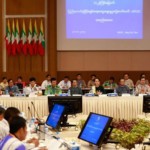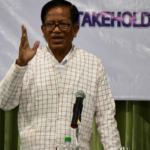By Sai Wansai / Shan Herald Agency for News (S.H.A.N.) | May 29, 2017
The second Union Peace Conference – 21stCentury Panglong (UPC-21CP) was held by the National League for Democracy (NLD) government from May 24 until 29, one day more than according to the schedule. The first one was also convened by the same regime in August-September in 2016.
Actually, the first peace conference that was then officially termed as Union Peace Conference (UPC) was held by the former Thein Sein regime, in January 2016, shortly before he left office, following the NLD’s land-slide election victory by the end of 2015 but only came into office in March 2016. Thus, the recent May peace conference is the third of its kind, but taken as the second one under the banner of the UPC – 21CP.
The difference between the first UPC-21CP and the second one is that while the first one could be hardly called a conference, as it was just a political position paper delivering forum where some 72 papers were read, without discussion or assessment, the second one seek to lay down the preliminary general principals on how the formation of a federal union should be achieved.
The first UPC-21CP was attended by most 21 Ethnic Armed Organizations (EAOs), with the exclusion of Kokang, Ta’ang and Arakan armies, while the second one involved the said three under the banner of the Pangkham alliance. But the United Nationalities Federal Council (UNFC) that was there at the first conference chooses to stay away, due to the assumption that it was being slighted and ignored on its 9-point proposal to amend the Nationwide Ceasefire Agreement (NCA) to be a level playing field by the government, in addition to being pushed either to sign the Deeds of Commitment (DoC) first or the NCA at a later date or immediately.
Oddly enough, while the UNFC stayed away, the Pangkham alliance that most didn’t expect to be at the conference was suddenly there. Thanks to the Chinese intervention on leadership level, with promise from its President Xi Jinping to help Myanmar out of the peace deadlock, followed by the shuttle diplomacy of Sun Guoxiang, the special envoy for Asian affairs of the Chinese Foreign Ministry, between the Pangkham alliance, Suu Kyi and Min Aung Hlaing.
However, as expected earlier the Pangkham alliance only attended the opening ceremony and later met the government’s PC headed by Tin Myo Win, Suu Kyi’s top peace negotiator and later with Suu Kyi, including visiting her at home for more trust-building and further communication, according to the various news reports.
Reportedly, the alliance was said to have distributed its booklet to journalist on “Amendment proposal of the nationwide ceasefire agreement timeline between the Wa State and Myanmar Government” and also delivered its separate position paper to Suu Kyi, on its proposed version of ceasefire agreement, following the visit to her home.
Now let us have a closer look of what this second UPC-21CP has been able to deliver or push us any further to the path of national reconciliation and peace.
Nationwide Ceasefire Agreement and Pangkham alliance game plan
A new game plan initiated by the Pangkham alliance group involving 7 EAOs that rejects the government’s NCA-based game plan has been in existence for sometimes. But latest development now indicates the alliance might go along if the government accepts alterations to the NCA. Reportedly, it produced a new ceasefire proposal version concerning only military matters, unlike the present NCA which is a mixture of both politics and military issues.
The Pangkham-led 7 EAOs military-political alliance includes the United Wa State Party/Army (UWSP/UWSA), United League of Arakan/Arakan Army (ULA/AA), Kachin Independence Organization/Army (KIO/KIA), Palaung State Liberation Front/Ta’ang National Liberation Army (PSLF/TNLA), Myanmar National Truth and Justice Party/Myanmar National Democratic Alliance Army (MNTJP/MNDAA), Peace and Solidarity Committee/National Democratic Alliance Army (PSC/NDAA) and Shan State Progress Party/Shan State Army (SSPP/SSA).
Pangkham insisted that the NCA-based peace process is not working, as it is unable to stop the war in Kachin and Shan States in the first place, besides being a process aimed at replacing the Panglong Agreement of 1947, which the alliance considers to be their historical-political legacy vested with rights of self-determination, equality and democracy and also the sole legal bond, to form a new political entity called the Union of Burma, between the ethnic nationalities and the Bamar state prior to the independence from the British in 1948.
Thus, the Pangkham alliance consideration was originally to end the war in the north of the country first, followed by political negotiation and eventual political settlement. But this uncompromising attitude changed to the demand for alteration of the NCA, when on May 25, the UWSA representative delegation made known of its booklet “Amendment proposal of the nationwide ceasefire agreement timeline between the Wa State and Myanmar Government”, dated April 30, 2017, to the media.
The booklet said that due to China’s pressure the UWSA has changed its stance to amend the NCA and requested the government and Tatmadaw accordingly.
It wrote China has been pressuring the Wa and Special Region 4 (Mong La) repeatedly to sign the NCA. “In order to respond to the Chinese opinion and demand, including considering the fact to guard and protect peace along China-Myanmar border area, and to overcome the difficult peace process, after careful consideration Wa State has changed its opinion of not wanting to sign (the NCA),” according to report.
The booklet further said that although it has changed its position to amend the NCA and tried to work out a solution with the Tatmadaw and government, it was not successful, as the Tatmadaw finally made public that the NCA could not be amended and would firmly stick to it.
“To find solution to the northern Myanmar armed conflict and tranquility of Myanmar-China border area, Wa State would try its utmost to find answer (solution) and would not easily start armed engagement,” according to the booklet.
Commander-in-Chief, State Counselor and Mutu Say Poe opening speeches
In response to the stance of Pangkham alliance now officially named Federal Political Negotiation and Consultative Committee (FPNCC), Commander-in-Chief Min Aung Hlaing made a remark on May 24 in his opening speech. He said: “Ignoring this (NCA) and pursuing other or the second way will be an attempt to loathe the establishment of a Union based on peace, democracy and federalism. As such, we have to assume that the attempt is tantamount to grabbing power and splitting from the Union through armed struggle line,” according to recent report of the Global New Light of Myanmar.
He further stressed: “Studying 72 papers submitted at the previous conference, we came to notice that the discussions, activities and basic concepts of some ethnic groups are far beyond the federal system, which is the right of autonomy. Such acts go against the desires and interest of the people who have high expectations of the democracy cause and peace process. As an institution responsible for protecting the interests of the State and the people, the Tatmadaw has to face any organization committing destructive acts in line with its responsibility.”
State Counselor Aung San Suu Kyi’s conciliatory tone, laced with responsible attitude that all should follow, impressed many when she said in her opening speech on May 25: “Almost everyone accepts that the resolution to our country’s long-running armed conflicts is a federal system that is acceptable to all. Our goal is therefore the “emergence of a democratic federal union based on democracy and federalism”. Whether or not we will achieve this goal rests in all of our hands. It is a responsibility that falls on all of our shoulders. I do not think that any of us would wish to avoid, reject or shrink away from this responsibility.”
“We will not resort to exerting pressure through populist politics, or coercing others through political means to achieve our goals. We will instead strive to reach an agreement that is acceptable to all, based on open, frank and inclusive dialogue,” she further stressed with assurance.
The Karen National Union (KNU) leader Mutu Say Poe pointed out the implementation flaws by saying: “
“I want to stress that there are still other national ethnic armed groups who are stakeholders in building up a future federal nation. We cannot solve the problem covering the whole nation with only those who signed the NCA,” he correctly pointed out.
Union Peace Conference – 21st Century Panglong outcomes
Five major sectors of political, social, land and environment, economy and security were said to be discussed.
It was said that political and security sectors didn’t achieve desirable result, although the other three resulted in agreement, according to news reports.
Political sector discussion was said to be marred by the non-secession issue, which the Tatmadaw insisted to include in the preliminary agreement as a prohibition for the ethnic states to exercise secession.
The Shan Nationalities League for Democracy (SNLD) was particularly against it putting out statement saying: “In the pursuit of [the three national causes] reconciliation among ethnic people, non-disintegration of the union and perpetuation of the sovereignty, the sentence ‘Any unit of the Union must never secede from the Union’ is not appropriate to put as one of the basic principles,” said the SNLD statement.
“In building union, instead of having worries, doubts and fear as the basis of the process, the SNLD believe that having mutual understanding, respect and trust would be constructive for the process,” said the statement.
An EAO representative was said to have tabled a proposition, to break the deadlock, that as long as rights of self-determination, equality, democracy and federalism are practiced there would be no secession. But this was also shot down, as the government-military group insisted upon the inclusion of the non-secession clause by all means.
Regarding security sector, heated argument was said to have taken place on even how the national defense force should be named, besides the major argument debate over maintaining just one national army. According to Restoration Council of Shan State (RCSS) representative, Sai Ngyin, negotiation has been going on at this writing, on whether the national army should be named “Tatmadaw”, as has always been called by the Military or “Federal Army”, as preferred by the EAOs, reported SHAN on May 26.
Analysis
Summing up the recent gathering in Nay Pyi Taw, it could be said that it still is not within the category of all-inclusiveness, as the 5 UNFC members and the National Socialist Council of Nagaland-Khaplang (NSCN-K) were not present. Besides, the 7 EAOs from Pangkham alliance were only there for the opening ceremony of the conference and did not participated in the process in the following days agendas.
But the positive development is that the government faction has diversified the process by welcoming and meeting the Pangkham alliance under its PC capacity and open up communication channel for further talks regarding the alliance’s wish on NCA amendment, so that it could also sign the agreement.
In a sense, this could be now viewed as an approach somewhat like what the UNFC has been proposing all along. Thus it would now mean that the State Counselor’s PC team would negotiate with the Pangkham alliance and also with the UNFC further for NCA alteration, and the groups’ count outside the NCA would remain the same as before.
The only remaining concern would be whether the government PC’s and Suu Kyi’s welcome of the alliance, termed as a social visit, to Nay Pyi Taw could be translated into the Tatmadaw’s withdrawal of offensives in Kachin and Shan States, to pave way for further negotiations.
If Min Aung Hlaing’s mild threat in his opening speech “to face any organization committing destructive acts in line with its responsibility” would mean to apply to those not signing the NCA immediately, without alteration proposal from the non-signatory EAOs being taken into account, war would likely go on as usual. But if the Tatmadaw would be lenient and broad-minded, it would refrain from doing so like in the recent past and give peace a chance, the war in the country’s north might as well quiet down.
As for the ambitious plan of the UPC-21CP, meaningful, preliminary, general guideline for the formation of a federal union, it hasn’t been able to be achieved. The main two reasons being, as usual, the inability to be an all-inclusive participation of all EAOs and the other, the incapacity to let all the ethnic states and ethnic nationalities, even for the major dominant ethnic groups like Kachin, Shan, Karenni, Mon and Arakan, according to its own NCA guidelines, to hold political dialogue among their people.
The issue of all-inclusiveness which the government and Tatmadaw wanted to treat as not important is, in fact, a major stumbling block.
According to the “Deciphering Myanmar’s Peace Process: A Reference Guide 2016” report publication of Burma News International, January 2017, the combined 21 EAOs troops, when added together is 81,700.
The Pangkham alliance members UWSA has some 30,000; the KIA 12,000; SSPP 8000; TNLA 6000; NDAA 3000; MNDAA 2000; and AA 3000; totaling 64,000 or 78% of the whole EAOs’ fighting force.
It is hard to imagine that it could achieve success by going about issuing preliminary policy guidelines to achieve “Union Accord” with only 22% EAOs’ participation and the incapacity to conduct national-level (meaning ethnic state-level) political dialogue to gather enough inputs from concerned ethnic nationalities and also sub-national groups, according to its own NCA rule.
All in all, the UPC-21CP is like the cart before the horse and it is all because the crucially important all-inclusiveness norm is not heeded from the beginning and the powers that be have been employing its ill-advised “open door”strategy, to woo the non-signatory EAOs one after another. As all could see since October 2015, not even one from the 13 non-signatory EAOs has joined the fray, even with massive military pressures in Kachin and Shan States.
Regarding the achievement of the second UPC-21CP, the political and security sector discussions have proven to be difficult and no compromised agreement could be found between the representatives attending the conference.
However, on the final day of the conference 37 adopted principles out of 41, proposed by the Union Peace Dialogue Joint Committee (UPDJC) and resulting from state and regional level political dialogue, included 12 with the political sector, 11 with the economic sector, 4 with the social sector and 10 with the land and environment sector.
The 37 agreed principles, in accordance with the NCA, were signed by leaders of participating groups of the government, parliament, military, 8 NCA-signatory EAOs and political parties, which the UPDJC Chairperson Aung San Suu Kyi thanked by saying: “The signing of today’s agreements is a massive step in the realization of national reconciliation, peace and democratic federal union.”
According to VOA report of May 28, it was said that the political sector’s “non-secession” issue; and security sector’s “one national army” and “Tatmadaw versus Federal Army” naming issues would be carried on to the next UPC-21CP for further discussion, as no compromise and agreement could be made among the government-military, EAOs and political parties.
In spite of all these, Suu Kyi’s move to welcome the Pangkham alliance is the positive approach and the way to go, which would even be better if this could be extended to the UNFC, with necessary accommodation to its amendment proposal of about a year ago.
The eventual amendment of the NCA according to the UNFC’s nine-point proposal, which includes genuine nationwide ceasefire announcement by the Tatmadaw, real tripartite dialogue composition – government, parliament, military; EAOs; and political parties; – in all levels of the peace process and sincere promise to build a real federal union, would definitely pave the way for eventual Pangkham alliance involvement, reconciliation and national harmony that all have been longing for decades.
This article was originally published by S.H.A.N. on May 29, 2017.






